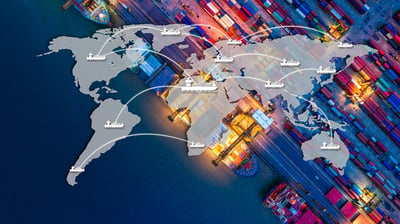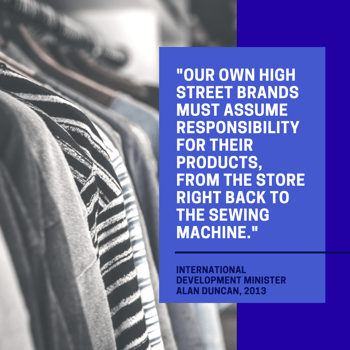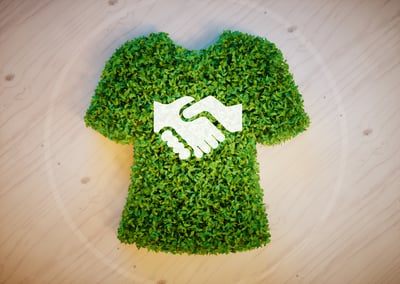Sustainable sourcing, or socially responsible procurement, according to the Institute for Supply Management is "a framework of measurable corporate policies and procedures and resulting behaviour designed to benefit the workplace and, by extension, the individual, the organization, and the community." This includes environmental, ethical, health and safety and human rights considerations. Fundamentally, this extends beyond the core business, across its entire functions and including their supply chain.
Sustainability expert John Elkrington’s concept of the Triple Bottom Line outlines the three areas where businesses can address sustainability:
- People – human rights, health and safety and employee right
- Planet – protecting the environment, both locally and globally
- Profit – profit making aspects of a business
SUSTAINABLE SUPPLY CHAINS
In a recent report, EY worked with the UN Global Compact to explore how companies are embedding sustainability in their supply chains by managing risks and adopting corporate commitments to human rights, ethics, the environment and the communities from which they source goods and services.
With the adoption of the United Nations (UN) 2030 Agenda and the Sustainable Development Goals (SDGs), we have entered a period where the world’s nations have committed to ending global poverty, protecting our planet and promoting a life of dignity for all.
Ole Lund HansenUN Global Compact
Their report echoes the voices of more than 100 sustainability, supply chain and procurement specialists from 70 companies globally.
 Supply chains today are global, dispersed and come with a host of complex challenges to businesses, retailers and brands around the world. In order to move towards a sustainable approach, retailers and brands need to work in collaboration with suppliers, peers, governments, communities, academia and NGOs. Through this level of collaboration, we can gain an in-depth understanding of how to address the issues raised. There then needs to be a recognised financial and time investment made into building more responsible supply chains.
Supply chains today are global, dispersed and come with a host of complex challenges to businesses, retailers and brands around the world. In order to move towards a sustainable approach, retailers and brands need to work in collaboration with suppliers, peers, governments, communities, academia and NGOs. Through this level of collaboration, we can gain an in-depth understanding of how to address the issues raised. There then needs to be a recognised financial and time investment made into building more responsible supply chains.
The role of business is key in achieving these goals. The SDGs provide a new common language for all stakeholders, including business, to establish goals and ambitions. The 2030 Agenda is a wake-up call and offers a new benchmark for the business of tomorrow.
Ole Lund HansenUN Global Compact
In order to progress with supply chain sustainability, the report suggests that the topic of sustainability needs to be a set priority at the top of an organisation. For example, if a CEO views their supply chain as an extension of the company’s workforce and community, then the expectations and company practices in key areas, such as selection, training, auditing and remediation, would be set for the suppliers within it. The report states that “It is also important to create a broader understanding within an organization — for example, among legal staff, product developers and marketing — of how decisions made beyond procurement have impacts on the supply chain.” Retailers and brands might be best to view their supply chains as a whole, including all suppliers within and beyond the first tier, as these suppliers are a level or more removed, they could have the most significant risks or challenges around addressing sustainability issues.
In order to support and aid the integration of supply chain sustainability, the UN Global Compact works to uncover and promote leading practices, tools, and innovative approaches, to develop guidance. This work includes the collaboration with EY to deliver a report which carefully highlights recommended actions to take to develop more sustainable supply chains and demonstrating the main challenges that they might face.
SUPPLIER MANAGEMENT
Supplier relationship management is a core part of any sourcing role, particularly considering legislation changes in recent years, the impact that unsustainable sourcing is having on our planet and increasing consumer awareness. For businesses with a globally dispersed, outsourced supply chain, suppliers are the cogs that keep the wheel turning. In an age of digital transformation, suppliers are key when it comes to innovation and improving products, services and business processes.
By creating strong supplier relationships and, as the EY report suggests, really viewing them as an extension of your own business, not only can business operations run more smoothly, but retailers can also protect their brand image when it comes to negative press.
Being a global brand comes with a lot of responsibility. We take this responsibility very seriously, within all of our processes, in all of our markets.
H&M
H&M work closely with their suppliers to improve working conditions within supplier factories – the greater visibility achieved through these closer relationships allows for greater control over sourcing materials, ultimately protecting the brand from being caught out.
 Supplier management is about more than just relationships. True control comes from visibility. Fashion brand Ted Baker declared their use of the Segura platform in their latest Modern Slavery Act statement, to ensure that they have visibility beyond their first tier of supply. In a bid to enhance their already strong supplier relationships, Ted Baker are using the single portal to improve supplier engagement and mapping, as well as ensuring that their suppliers meet the required standards.
Supplier management is about more than just relationships. True control comes from visibility. Fashion brand Ted Baker declared their use of the Segura platform in their latest Modern Slavery Act statement, to ensure that they have visibility beyond their first tier of supply. In a bid to enhance their already strong supplier relationships, Ted Baker are using the single portal to improve supplier engagement and mapping, as well as ensuring that their suppliers meet the required standards.
Mature companies are expanding their relationships significantly beyond auditing and monitoring, and are investing in training and capacity building (either individually or through industry collaborations) and incentives for the top performers. They work with suppliers toward shared commitments as they recognize that suppliers, vendors and subcontractors play an important role in achieving their sustainability goals and those of their customers. These companies increasingly give procurement process preference to suppliers who can help them achieve these goals.
EY Report
GAINING A TRANSPARENT SUPPLY CHAIN
Transparency can come with some challenges but the advances in technology as well as the understanding of how to use those technologies, is wider reaching and is easier to access than ever before. Mapping your supply chain is the first step but more needs to be done. EY say that:
Transparency and traceability, especially beyond Tier 1 suppliers, were identified by all companies as a major challenge. While stakeholder expectations for reporting and disclosure related to sustainability topics have significantly increased in the past few years, companies still do not have a good understanding of the risks deeper in the supply chain.
It seems that in order to gain this level of transparency there must be recognition at CEO level, and a real drive throughout the whole business to work towards these discovery goals. Impacts and measures need to be reviewed and accepted in every process, and responsibility taken in achieving the standards required.
Our own high street brands must assume responsibility for their products, from the store right back to the sewing machine.
International Development Minister Alan Duncanfollowing the Rana Plaza disaster in 2013ORGANISATIONAL CHANGE
 Achieving successful sustainable sourcing requires more than just action; it requires a total overhaul of how we do business. This involves analysing what we produce, how we produce it, who produces it, how it is used and how it is disposed of.
Achieving successful sustainable sourcing requires more than just action; it requires a total overhaul of how we do business. This involves analysing what we produce, how we produce it, who produces it, how it is used and how it is disposed of.- Assess materiality to focus on the most pressing value chain issues, taking into consideration the UN Global Compact principles
- Align resources, structures and processes focused on supply chain sustainability across the whole organisation
- Train management and suppliers on market practice
- Invest in diverse and inclusive supply chain
- Stretch sustainability goals beyond direct operations across the tiers of the supply chain
- Deploy technology to increase accountability, transparency and traceability
- Create a shift toward supply chain sustainability by leveraging buying power and influence
- Disclose supply chain information beyond the sustainability reporting mechanisms
BIG DATA
UNDERSTANDING, COLLABORATION AND TECHNOLOGY ARE CRUCIAL
 Collaboration is also crucial in effecting change. Working together with peers, industry associations and NGOs is critical to achieve sustainability in any supply chain. Only by sharing data, experiences and talking openly about discoveries will provide the insight required to take action. There is still some reluctance to share issues uncovered in supply chains, due to fear of brand damage. However, being bold in your approach can win the hearts and minds of consumers and result in higher consumer loyalty and success.
Collaboration is also crucial in effecting change. Working together with peers, industry associations and NGOs is critical to achieve sustainability in any supply chain. Only by sharing data, experiences and talking openly about discoveries will provide the insight required to take action. There is still some reluctance to share issues uncovered in supply chains, due to fear of brand damage. However, being bold in your approach can win the hearts and minds of consumers and result in higher consumer loyalty and success.Adam ElmanEveryone who shops in M&S stores arrives with the expectation of high quality and excellent value in our products as well as top shelf customer service…but they are also looking for us to take the lead in sustainable business practices. We are dedicated to the belief that the combination is what will support our brand for years to come.
Global Head of Delivery for Plan A
Marks and Spencer, one of the top 10 British retailers, has long had a focus on ethical and sustainable practices – not only as part of their Plan A commitments but as an integral part of their organisation. As a signatory of the United Nations Global Compact, as well as an outspoken advocate for change, Marks & Spencer recognise the need for working together.
Listening, learning, responding and working in partnership is an important part of how we do business.
Plan AMarks & Spencer
When it comes to technology innovations, its adoption is vital to truly capture, measure and ensure change is successful, this requires the understanding and buy in at a business level. For brands and retailers, one of the biggest challenges is believed to be achieving transparency beyond Tier 1 suppliers. EY details that “Companies are looking for smart connectivity with their IT solutions. They want to achieve transparency, enhance their supplier base and processes for managing suppliers, and improve the ability to assess and address issues at the supplier, factory, and mill and subcontractor levels. Traditional enterprise resource planning (ERP) and supplier management systems alone - cannot provide these desired capabilities.”
Technology solutions now need to include a platform that provides an interface between internal legacy systems and external suppliers. Even when you have mapped the Tier 1 landscape, brands and retailers will have varying levels of visibility of their suppliers, which will include factories and regions for where their products are sourced. Typically, as the EY report suggests, it is assumed that brands and retailers are working on a risk-based approach that provides them with some comfort that risks associated with their Tier 1 suppliers are being managed. However, according to the EY report, many companies surveyed suggested that moving into Tier 2 and beyond, to understand the landscape of subcontractors contributing to their supply chains, presented significant challenges and uncertainty.
If there’s one thing that reigns true it’s that you can’t manage what you can’t measure. Even with the wealth of technology available today, most supplier relationships are still built on trust. So, you are unable to track whether or not unknown suppliers are producing your products and therefore not adhering to sustainability or ethical code of practices and limiting their environmental impacts.
Having visibility and strong supplier relationships at the first tier of the supply chain is clearly no longer enough, as these risks do not always exist in the first tier, but often further down supply chains.
Dave NobleCEO, CIPS
SUPPLIER CAPTURE AND VALIDATION
Segura is different, we believe that it is possible to create fashion that is ethical and desirable with a short lead time, but this cannot be achieved without embracing supply chain technology. The Segura platform gives our customers the ability to capture all of the transactions within their entire supply chain, at every tier. Our collaborative platform allows you and your suppliers to use, capture and track each tier of the supply chain. Through Segura it is possible to map your entire supply chain, confirm all of your suppliers and to calculate, rather than estimate, the environmental impact.
Originally Published 30/10/2018

